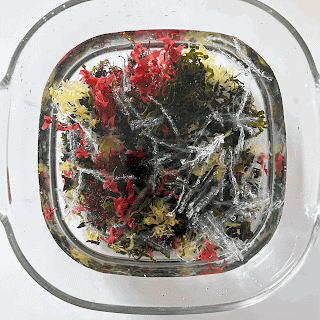Seaweed Salad Bibimbap My Oldest Was Craving—Now We're All Hooked
For days, my oldest kept saying, "I really want that seaweed salad bibimbap..." I had no idea where to find it, but of course, Coupang had it—because what don’t they have?
Since we’d never tried it before, I didn’t want to risk buying a large pack. I ordered just two small ones to test the waters. If it turned out delicious, we could get more. If not, oh well—just a small price for the experience.
Seaweed Salad Bibimbap Kit by Gijangmulsan
When I added it to the cart, I couldn’t tell how big the package would be. “Small-sized” sounded safe enough, so I went with two. But when they arrived—oh my! They were tiny
I wondered if Gijangmulsan was a brand that specializes in local products from Gijang.
I tore open the pack before remembering I should probably take a photo for the blog—classic me. On the left is an unopened pack, and on the right, you can see what’s inside: a little pouch of dried seaweed and a small bibimbap sauce packet. Just enough for one.
Now, let’s flip it over and see what’s actually in it.
What Types of Seaweed Are Inside?
According to the label, it includes:
Korean: miyeok (sea mustard), dasima (kelp strips), miyeok julgi (sea mustard stems), saemogasa-ri
Canadian: red jindubal and yellow jindubal
I was familiar with most of them—except for those last three. So I looked them up:
1. Saemogasa-ri (세모가사리)
Look & Texture: Thin, triangle-shaped strands; chewy yet tender.
Flavor: Mild and slightly sweet with a fresh ocean aroma.
Uses: Great in salads, soups, stir-fries, or bibimbap for extra texture.
Nutrition: High in calcium, iron, fiber, and essential minerals.
2. Yellow Jindubal (황진두발)
Look & Texture: Dark brown or black, thin like threads; softens when cooked.
Flavor: Briny and rich in umami.
Uses: Soups, stews, stir-fries; also used in fermented dishes.
Nutrition: Packed with iodine, fiber, calcium, and iron.
3. Red Jindubal (적진두발)
Look & Texture: Reddish-purple strands, similar to yellow jindubal but distinguishable by color.
Flavor: Chewy with a deep seaweed flavor; slightly more elastic.
Uses: Ideal in soups, salads, stir-fries, and for visual appeal in dishes.
Nutrition: Loaded with vitamins, fiber, and minerals.
In short, saemogasa-ri brings the crunch, while the jindubal seaweeds offer ocean flavor and chewiness—perfect for mixing into rice.
How to Prepare It?
The instructions were printed right on the top:
Soak the dried seaweed in water for 3–5 minutes, rinse, drain, then mix with the included sauce. I followed the steps exactly!
Step 1: Rehydrate the Seaweed
I figured clean water was better than tap, so I used filtered water to soak both packs in a bowl. The seaweed expanded instantly
The yellow strands were probably yellow jindubal, the red ones red jindubal, and the purple-ish ones must’ve been saemogasa-ri.
Though it only needed 3–5 minutes, I soaked it for 8 minutes since we were sharing it among three people. I also added extra water as it soaked.
It reminded me of how dried seaweed expands dramatically when you make miyeok-guk (seaweed soup). Remember that old joke about someone eating dried seaweed and falling asleep—only to wake up in trouble? Classic radio humor.
I drained the seaweed in a colander. While waiting, I thinly sliced a cucumber and made a new sauce.
The included bibimbap sauce looked spicy, and my family can’t handle heat. So I whipped up a gentler soy-based sauce with perilla oil and a touch of honey—using leftover garlic soy sauce from a previous pickle batch.
We planned to use the new sauce as the base, with the spicy packet as an optional add-on.
Step 3: Assemble the Bibimbap
I scooped rice into bowls, topped it with cucumber slices, then added the rehydrated seaweed on top.
Soak dried seaweed in water for 5 minutes.
Rinse and drain thoroughly.
Place over rice and mix with sauce. (Or skip the rice for a seaweed salad!)
So, How Did It Taste?
Crunchy~ chewy~ smooth~ snappy~ crisp~ The mix of textures from the seaweed and cucumber made it so fun to eat. The flavors? A perfect balance of salty-sweet, tangy, and clean.
And yes—the spicy sauce made it taste just like hoe-deopbap (Korean sashimi rice bowl). No wonder they pair it with heat. But if you prefer mild, the soy-based version works perfectly too.
The best part? No fishy seaweed smell. My youngest loves stir-fried seaweed stems, but my oldest normally hates that ocean taste. This time, they took a bite and said, “Mmm!!” with a big thumbs-up.
 |
| Seaweed in the wild – photo via Wikimedia (CC BY-SA 4.0) |
Here’s a look at the sauces: Left is the original spicy one, right is the soy-based one I made. My husband and oldest used mine, while I mixed both together. Yum!
Here’s a —I wish I’d seen this earlier. I’ll definitely get this next time.
Related Post:
A regular favorite of ours—fresh vegetables with bulgogi topping, seasoned sauce, and sometimes doenjang-jjigae or young radish kimchi on the side. Occasionally, we add eggplant or cucumber soup too!
#KoreanFood #Bibimbap #SeaweedSalad #EasyKoreanRecipe #HealthyLunch #VegetarianBibimbap #AsianCuisine #KoreanCooking #SeaweedLovers #QuickMeals #BibimbapRecipe #HarutipEats






Comments
Post a Comment